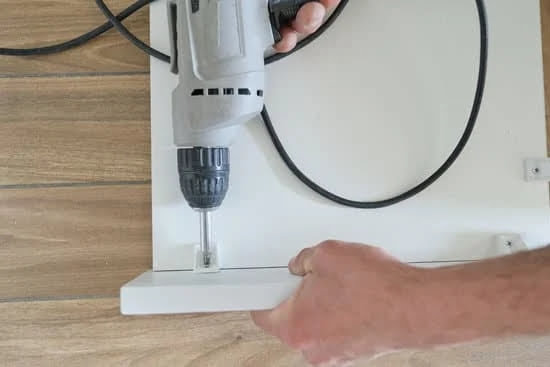Are you supposed to wax original woodwork in your home? Original woodwork adds character, warmth, and charm to a space, making it a highly sought-after feature in many homes. However, preserving and maintaining this beautiful woodwork requires proper care and attention. In this article, we will delve into the significance of original woodwork in a home and explore the role of wax in its maintenance.
Original woodwork embodies craftsmanship and history, often serving as a focal point that enhances the overall aesthetics of a room. Whether it’s intricate moldings, stunning hardwood floors, or ornate cabinetry, preserving the natural beauty of these elements is essential for upholding the integrity of a historic or vintage property. Waxing is commonly recommended as a method to protect and nourish original wood surfaces while enhancing their luster.
While waxing can provide numerous benefits such as creating a protective barrier against moisture and dust, there are also drawbacks to consider. Some may find that waxing requires consistent upkeep and may attract dirt or grime over time. Understanding the pros and cons of waxing original woodwork is crucial in determining the best approach to maintaining these cherished features in your home.
What Is Wax and Its Role in Maintaining Wood Surfaces
Wax is a natural substance that has been used for centuries to protect and beautify wood surfaces. It is typically made from a combination of beeswax and carnauba wax, which provide a protective barrier against moisture, dust, and dirt. When applied to woodwork, wax helps to enhance the natural grain and color of the wood while creating a smooth and shiny finish.
Benefits of Waxing Original Woodwork
One of the main advantages of waxing original woodwork is its ability to provide a long-lasting protective layer that prevents damage from everyday wear and tear. Additionally, wax can help to repel water and other liquids, reducing the risk of stains or discoloration on your wood surfaces. Another benefit of using wax on woodwork is its ease of application – simply apply the wax with a soft cloth or brush, allow it to dry, then buff it to a shine.
Drawbacks of Waxing Original Woodwork
While there are many benefits to using wax on original woodwork, there are also some drawbacks to consider. One potential downside of using wax is that it may need to be reapplied regularly in order to maintain its protective properties.
Additionally, wax can sometimes attract dust and dirt if not properly maintained, which can detract from the beauty of your wood surfaces. Lastly, some types of wood may not respond well to waxing and could become discolored or damaged over time.
Overall,“wax” is an essential product when it comes to maintaining original woodwork in your home. Its ability to protect against moisture and wear while enhancing the natural beauty of wood makes it a popular choice for homeowners looking to preserve their wooden furniture or fixtures.
Pros and Cons of Waxing Original Woodwork
Waxing original woodwork can be a controversial topic among homeowners and woodwork enthusiasts. There are both pros and cons to consider when deciding whether or not to wax your wood surfaces.
Pros of Waxing Original Woodwork
One of the main benefits of waxing original woodwork is that it helps to protect the surface from moisture, dust, and other elements that can cause damage over time. Wax creates a protective barrier that can help prolong the life of the wood and maintain its natural beauty.
Additionally, waxing can enhance the sheen and color of the wood, giving it a more polished and sophisticated look. It is also relatively easy to apply and can be done by most homeowners without professional assistance.
Another advantage of waxing original woodwork is that it is a non-toxic and eco-friendly way to maintain your surfaces. Unlike some commercial wood treatments that may contain harmful chemicals, waxes made from natural ingredients are safe for both your family and the environment. This makes waxing a great option for those who are conscious about creating a healthy living space.
Cons of Waxing Original Woodwork
However, there are some downsides to waxing original woodwork that should be considered before making a decision. One potential drawback is that wax needs to be reapplied regularly in order to maintain its protective properties. Over time, the wax will wear off, especially in high-traffic areas, which means you will need to invest time and effort into maintaining your surfaces.
Additionally, some people may find that waxed surfaces can become slippery when wet, posing a safety hazard in certain areas of the home. This is something to keep in mind if you have young children or elderly individuals living in your household. Lastly, while wax can enhance the appearance of wood surfaces, it may not provide as durable or long-lasting protection as other types of finishes such as polyurethane or lacquer.
How to Determine if Your Woodwork Needs Waxing
When it comes to maintaining original woodwork in your home, one of the key considerations is whether or not you should wax the wood surfaces. Waxing can be a beneficial practice for preserving and enhancing the beauty of your woodwork, but it’s important to know when it is necessary.
One of the first steps in determining if your woodwork needs waxing is to assess the current condition of the surfaces. Look for signs of wear and tear, such as scratches, dullness, or a lack of luster. If the wood appears faded or dry, it may be time to consider waxing as a way to revitalize and protect the original finish.
Additionally, another factor to consider when deciding if your woodwork needs waxing is how frequently the surfaces are used and exposed to various elements. High-traffic areas like entryways or tabletops are more likely to require regular waxing compared to less-used areas. Exposure to sunlight, moisture, and other environmental factors can also impact the condition of the wood and indicate whether waxing is needed.
| Woodwork Condition | Signs That Waxing May Be Needed |
|---|---|
| Faded or dry appearance | Scratches, dullness, lack of luster |
| High-traffic areas | Frequent use and exposure to elements |
Step-by-Step Guide on How to Properly Wax Original Woodwork
Woodwork adds a touch of elegance and warmth to any home, especially when it’s original. Maintaining the beauty and integrity of original woodwork is essential to preserve its natural charm. One effective way to care for your woodwork is by waxing it.
Wax is a natural substance that can enhance the appearance of wood surfaces while providing protection against moisture and scratches. It creates a thin layer on the surface of the wood that helps to repel liquids and prevent damage from everyday wear and tear. Additionally, wax can bring out the natural grain and color of the wood, giving it a rich and beautiful sheen.
Before you start waxing your original woodwork, it’s important to assess its current condition. If the wood looks dull, dry, or has visible scratches, it might be time for a wax treatment. You can also perform a simple water test by sprinkling some water on the wood surface – if it beads up, then the existing finish is still protecting the wood.
| Pros of Waxing Original Woodwork | Cons of Waxing Original Woodwork |
|---|---|
| Enhances appearance | Needs regular reapplication |
| Protects against moisture | Can build up over time |
| Brings out natural grain | Requires more effort than dusting |
Alternative Methods for Maintaining Original Woodwork Without Wax
Maintaining original woodwork in your home is crucial for preserving its beauty and charm. While waxing is a popular method for caring for wood surfaces, there are alternative methods you can consider to keep your woodwork looking its best without using wax. Here are some effective ways to maintain original woodwork without wax:
- Regular dusting: One of the simplest ways to care for original woodwork is by regularly dusting it with a soft cloth or duster. This helps prevent the buildup of dirt and grime, keeping the wood looking clean and well-maintained.
- Use a gentle cleanser: Instead of wax, you can opt for a mild cleanser specifically formulated for wood surfaces. Make sure to follow the manufacturer’s instructions and test the product on a small, inconspicuous area before applying it to the entire surface.
- Polishing with natural oils: Natural oils like olive oil, coconut oil, or linseed oil can be used to polish and nourish original woodwork. Simply apply a small amount of oil onto a soft cloth and rub it onto the wood in circular motions. This will help enhance the natural beauty of the wood and provide protection against moisture.
While waxing may be a traditional method for maintaining original woodwork, these alternative methods can be just as effective in keeping your wood surfaces looking their best. Experiment with different techniques to find what works best for your specific type of wood and finish. Remember to always take proper care of your original woodwork to ensure its longevity and beauty for years to come.
Common Mistakes to Avoid When Waxing Woodwork
When it comes to maintaining the original woodwork in your home, waxing can be a popular choice. However, there are some common mistakes that people make when waxing their wood surfaces that can impact the overall appearance and longevity of the wood.
One of the most common mistakes is using the wrong type of wax for your specific type of woodwork. It is important to choose a high-quality wax that is suitable for the type of wood you have to ensure the best results.
Another common mistake to avoid when waxing woodwork is not properly preparing the surface beforehand. It is essential to clean the wood thoroughly and remove any existing wax or debris before applying a new coat of wax. Failure to do so can result in an uneven finish and prevent the wax from adhering properly to the surface. Additionally, not buffing the wax properly after application can leave a sticky residue on the woodwork, detracting from its natural beauty.
Over-waxing is another mistake that homeowners often make when trying to maintain their original woodwork. Applying too many coats of wax can build up on the surface, creating a dull and hazy appearance over time. It is crucial to follow the manufacturer’s guidelines for proper application and reapplication intervals to prevent this buildup. By avoiding these common mistakes, you can ensure that your original woodwork remains beautiful and well-preserved for years to come.
Expert Tips for Maximizing the Beauty and Longevity of Original Woodwork
In conclusion, preserving the beauty and longevity of original woodwork in your home is a task that requires careful attention and proper maintenance. Waxing can be a valuable technique in keeping wood surfaces looking their best, providing a protective layer that enhances the natural richness of the wood. However, it is important to weigh the pros and cons of waxing before deciding if it is the right approach for your specific woodwork.
When considering whether to wax your original woodwork, it is crucial to assess the condition of the wood and determine if it truly needs waxing. Signs such as dullness, dryness, or lack of luster may indicate that it is time to apply wax. A regular cleaning routine combined with occasional waxing can significantly extend the life and beauty of your woodwork, preventing irreversible damage such as discoloration or warping.
For those who choose to wax their original woodwork, following a step-by-step guide for proper application is essential. From preparing the surface to selecting the right type of wax for your specific wood finish, attention to detail can make all the difference in achieving optimal results.
Additionally, exploring alternative methods for maintaining original woodwork without wax can provide additional options for protecting and enhancing your cherished wooden surfaces. By incorporating expert tips into your routine maintenance practices, you can ensure that your original woodwork remains a timeless centerpiece in your home for years to come.
Frequently Asked Questions
Does Wood Need to Be Waxed?
Wood does not necessarily need to be waxed, but applying wax can provide protection and enhance the appearance of the wood. Waxing can help seal the wood surface, prevent moisture penetration, and add a subtle sheen.
What Are the Disadvantages of Wax Finish on Wood Furniture?
There are some disadvantages to using wax finish on wood furniture. One potential issue is that wax finishes may not be as durable or long-lasting as other types of finishes like polyurethane.
Additionally, wax can attract dust and dirt more easily, requiring more frequent cleaning. Over time, wax finishes may also need to be reapplied to maintain their protective properties.
How Do You Wax Antique Wood?
To wax antique wood properly, it is important to first clean the surface thoroughly to remove any dirt, dust, or debris that could interfere with the wax application. Once the wood is clean and dry, apply a thin layer of high-quality paste wax using a soft cloth or brush in small circular motions.
Allow the wax to dry according to the manufacturer’s instructions before buffing it off with a clean cloth to achieve a smooth finish. Repeat the process if necessary for additional shine and protection for your antique wood piece.

Hi everyone! I’m a woodworker and blogger, and this is my woodworking blog. In my blog, I share tips and tricks for woodworkers of all skill levels, as well as project ideas that you can try yourself.





